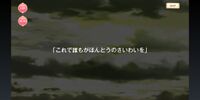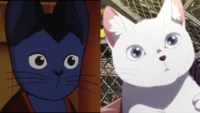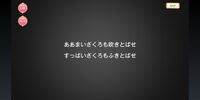Speculah:Kenji Miyazawa and Magia Record: Difference between revisions
Mokyubacky (talk | contribs) (→In-Game: added a caption for magpie) |
Mokyubacky (talk | contribs) (added information about Kuroe's Doppel) |
||
| Line 209: | Line 209: | ||
<br> | <br> | ||
* A phrase, "water-attribute Clammbon" appear in Episode 15 of the event story, [[Magia Record Story KamiFest: Kamihama Idol Festival 2020 |KamiFest: Kamihama Idol Festival 2020]]. Clammbon is [http://yamanasi.yoimikan.com/kuramubon.html an unidentifiable word] that appears in '''''Yamanashi'''''<ref name="Yamanashi"/>. | * A phrase, "water-attribute Clammbon" appear in Episode 15 of the event story, [[Magia Record Story KamiFest: Kamihama Idol Festival 2020 |KamiFest: Kamihama Idol Festival 2020]]. Clammbon is [http://yamanasi.yoimikan.com/kuramubon.html an unidentifiable word] that appears in '''''Yamanashi'''''<ref name="Yamanashi"/>. | ||
<br> | |||
* [[Kuroe]] was initially an anime-only character, but later appeared in the game. Kuroe's Doppel name "Ichizo" was first revealed in the game. This name comes from the novel '''''The Nighthawk Star'''''<ref name = "Nighthawk"/>. See also [[#Episode 18|below section]]. | |||
** The novel tells the story of a nighthawk (also called "[[:wikipedia:Nightjar|Nightjar]]" in English) who is despised by other birds as a very ugly bird. He decides to go somewhere far away by himself, flies to a much higher place in the sky, and finally becomes a star with a blue fiery light. In the first half of the story, the true hawk threatens to kill him if he doesn't change his name from "Nighthawk" to "Ichizo. The hawk, mighty and feared by the little birds, hates very much to share his name with the wretched him. | |||
===Anime=== | ===Anime=== | ||
| Line 300: | Line 303: | ||
|- | |- | ||
| [[File:S2E5 Kuroe Dopper 3.png|200px]] | | [[File:S2E5 Kuroe Dopper 3.png|200px]] | ||
| Kuroe's Doppel is shaped like a black bird. There is a possibility that it is a reference to the nighthawk. '''''The Nighthawk Star'''''<ref name = "Nighthawk"/> is generally accepted as a story with a strong sense of self-sacrifice. | | Kuroe's Doppel is shaped like a black bird. <del>There is a possibility that</del> it is a reference to the nighthawk. '''''The Nighthawk Star'''''<ref name = "Nighthawk"/> is generally accepted as a story with a strong sense of self-sacrifice. See also [[#In-Game_2|the above section]]. | ||
|} | |} | ||
Revision as of 15:50, 2 April 2022
This section may contain major spoilers!
Please refrain from reading if you are not yet familiar with all the latest media released.Kenji Miyazawa (宮沢 賢治 or 宮澤 賢治 Miyazawa Kenji, 27 August 1896 – 21 September 1933) was a Japanese novelist and poet of children's literature from Hanamaki, Iwate, in the late Taishō and early Shōwa periods (1926–1989). Some of his major works include Night on the Galactic Railroad, Kaze no Matasaburō, Gauche the Cellist, and The Night of Taneyamagahara.
Many of his works have been referenced by the mobile game Magia Record. This page will attempt to compile references to his work in both the game and the anime adaptation.
General
- Kenji Miyazawa was a utopian social activist. The Magius' goal is to erase the Witchification process from the Magical Girl system, and in doing so create a peaceful world for magical girls where they will not succumb to despair or fight over resources. The beginning stage of their plan, creating the Doppel field of Kamihama City where Magical Girls cannot become Witches while inside of it, essentially makes it a kind of Magical Girl utopia.
- Kenji Miyazawa learned the constructed international language Esperanto, which he translated several of his poems into. Kenji found the concept of a common international language interesting. Songs of the anime's soundtrack are titled in at least nine languages.
- Kenji's fascination with the international language may be connected to the idea of Magical Girls from many far-off places gathering together in Kamihama City.
- Kenji was a devout Buddhist, as were his parents of the Pure Land Sect. Ui Tamaki's name, from the same poem from which her sister Iroha gets hers, comes from a Buddhist term that means "caused by karma". Additionally, Madoka Kaname and her story can be interpreted as that of a Buddhist savior.
- A recurring theme of Kenji's that aligns with his personal philosophy and which appears in several of his works, including Night on the Galactic Railroad[1], is that of self-sacrifice, of giving oneself for the sake of others. This aligns with the overall role of Magical Girls, those who sacrifice their happiness, humanity, and ultimately lives for the survival of the universe, as well as the mindset of altruistic Magical Girls who aim to fight Witches for the safety of humanity, rather than out of obligation or for their own self-interests. Further, this especially relates to the story of Madoka Kaname, who gave up her very existence for the sake of Magical Girls across the universe and throughout all of history in the timeline of the original series.
Night on the Galactic Railroad[1]
Plot Summary of the Novel
This novel's protagonist, Giovanni, is a boy who tends to isolate himself from his surroundings due to the rumors related to his absent father. On the night of festival of the constellation Centaurus, he climbs the hill alone and watches the night sky, instead of joining the festival.
As he gazes up at the Milky Way, Giovanni suddenly finds himself with his best friend, Campanella, onboard a train. That train had been running on a railway laid on the shore of the Milky Way in the night sky. Shortly before they reach their first stop, they look out the window to see the Northern Cross. At their first stop, Swan Station, they get off and stop at Pliocene Beach. After they board the train again, they meet a bird-catcher who catches wild geese to turn them into candy. In a talk with the bird-catcher, Giovanni learns that the green ticket he has is a special one that can take him wherever he wishes. The bird-catcher disappears and a pair of young siblings and a young man appear in their place. They seem to have boarded the train after the ship they were on hit an iceberg and sank. They gaze at the Scorpio's fire from the window and have conversations about "true happiness" and "the only true God". At the Southern Cross, called Heaven, all the other passengers get off and Giovanni and Campanella are left alone again. They vow to go together as far as they can, for the sake of "true happiness of all people". However, after they passed the Coalsack, Campanella suddenly disappears after he tells Giovanni that there is a true heaven outside the window and that his mother is there.
At the top of the hill, Giovanni wakes up. He goes down to the town and hears that Campanella has jumped into the river to help rescue the bully, Zanelli, and has gone missing. Giovanni tries to tell Campanella's father where he has gone, but he informs him that Giovanni's father will be returning soon. Giovanni is choked with various emotions and heads home.
In-Game
- Giovanni is a protagonist in the story. Iroha Tamaki's Doppel's name, Giovanna is the feminine form of Giovanni.
- According to desingn note in Magia Archive Volume 1, her Doppel, Giovanna is the one, it wanders around from a sense of loss and loneliness and searching for "true happiness". The phrase "true happiness" is frequently used in the novel.
- The nature of Giovanni, "silence" may be a reference to the opening section of the novel. In first section, Campanella decides to answer a question in class instead of the shy Giovanni, only to stay silent so that Giovanni is less embarrassed.
- Ironically, in the animated adaptation of the novel, Campanella is depicted as pink, while Giovanni is blue.
- Because of his father's absence and his mother's illness, Giovanni works as a printing-type selector in a letterpress printing office. The selection for printing types is a process specific to letterpress printing in Chinese character culture. The design of Uwasa of the Memory Curator seems to be based on a letterpress printing machine.
- Doppel of Yachiyo Nanami is Campanella. Campanella is one of the main characters in the novel.
- The nature of Doppel Campanella, "ticket-taking" may also be an ironical reference to this novel. He is a best friend of Giovanni who owns the ticket to the galaxy.
- Yachiyo and her Doppel Campanella used water magic. Campanella jumped into the river and went missing in the story.
- The Doppel Campanella is designed to look like a scorpion, with a lantern strapped to the end of its tail. According to design notes in Magia Archive Volume 1, this is confirmed to be a reference to the same scorpion in the story. That scorpion ate other insects, but perished in a well after escaping another predator; regretting that it did not sacrifice itself for a good cause, it prayed to bring happiness to others, and its body became a bright flame that endlessly burned in the sky. Also, Campanella and Giovanni vow to sacrifice themselves for the sake of "true happiness of all people", like the scorpion,
- In an earlier edition of the novel, Professor Bulcaniro appears and encourages Giovanni soon after Campanella disappears. He is a pale-faced adult man with a large black hat and suggests that Giovanni experienced his journey on the Galactic Railroad through his experiments. Her Doppel is named after Campanella, but can be a reference to this mentor.
- Ironically, in the animated adaptation of the novel, Giovanni is depicted as blue, while Campanella is pink.
- The Doppel of Yachiyo (Tanabata ver.) is described as "have received the role of a Tanabata magpie". The magpies are not very common birds in Japan, but are known as birds which appear in the myth of Tanabata festival, a festival originating in China. The magpies also appear in the Night on the Galactic Railroad.
- The description of Mifuyu Azusa likely refers to a character, simply referred to as "the birdcatcher" in the novel. His "vocation" is to catch birds such as cranes, wild geese, herons and swans and sell them for food. He hands Giovanni and Campanella a goose he caught, but it somehow turns into candy.
- He is a hunched-over and red-bearded man dressed in a raggedy brown overcoat, and he is carrying his things, wrapped in white cloth, into two pieces and slung over his shoulder. Also, after he catches birds outside the train, suddenly throws his hands up in the air, shaped "like a soldier being hit by a shell and dying" and moves instantly into the train. The design of Mifuyu's Doppel may reference these descriptions about the birdcatcher in the novel.
- In the event story in 2018, Madoka Kaname becomes a Witch and says "Now everyone will have true happiness." in a dream. The phrase "true happiness" is frequently used in the novel.
- In the novel, Giovanni argues with the other passengers about " the only true God". Also, all passengers except Giovanni and Campanella are headed for "Heaven". Ultimate Madoka and the Law of Cycles are often likened to God and heaven and actually called so in the Puella Magi series.
- "the only true God" in the novel probably refers to the Christian God, but Giovanni seems unconvinced about the existence of the one. Also, he is taught by his teacher at school that they must "create a better place than heaven" and he probably agrees with that. In Magia Record, Wings of Magius tried to make the paradise for magical girls and Kamihama Magia Union are trying to achieve their ideal through more moderate methods. Also, The Law of Cycles can't currently interfere in the universe of Magia Record. This could also be a reference to the novel.
- In the novel, Campanella did not got off at the Southern Cross, but it is suggested that he heads for the "true heaven" after they passed the Coalsack. Just before he disappears, he says that he is not afraid of the darkness, such as the void of Coalsack. For Kyubey, magical girls are fuel like coal for mankind. This could be an allusion to the magical girl system.
- In the event story of 2021 summer which features Sayaka Miki, The song made by Miyazawa, "星めぐりの歌(Hoshi Meguri no Uta, lit. means "The song of traveling across the stars")" is featured. This song is used in the Night on the Galactic Railroad.
Anime
ED
- In the ED Aletheia, Yachiyo's falling into water could be a reference to Campanella's falling into a river.
Episode 1
| Image | Notes |
|---|---|
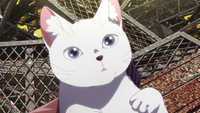
|
The cat that Iroha saves appears to be distinctively drawn to look similar face-wise to the characters in the 1985 film of the novel. That film is based on a manga by Hiroshi Masumura, who drew the main characters as cats. |
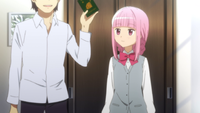
|
According to Director Miyamoto, Iroha's parents' green passports are an allusion to Giovanni's green ticket. In the novel, Giovanni's green ticket is a special one that can take him wherever he wants to go. |
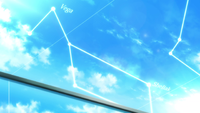
|
Takarazaki-Dai-sanji Station's glass ceiling features several constellations, in particular Lyra. Lyra and its star Vega are the last stars seen by Giovanni before he falls asleep and finds himself aboard the Galactic Railroad. This is also confirmed to be an allusion by Director Miyamoto. |
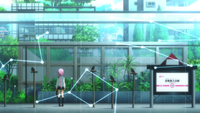
|
In the novel, a conductor asks Giovanni if his green ticket has been brought with him from "tertiary space". "Dai-sanji" literally means tertiary, so that station's name could also be a reference to the novel. |
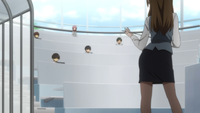
|
Iroha is asked a question in class pertaining to what the Milky Way is made of, similar to how the main character Giovanni is asked the same question but both are unable to answer. |
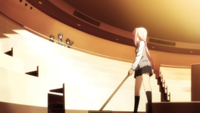
|
Similar to how Giovanni's father is out on a trip and he must take care of the house, giving him no time to study nor time with friends, Iroha is in a similar position where both of her parents are out on a trip and she is left by herself and appears to not hang out with any friends after school. |

|
There is a direct quote from the novel on the Uwasa Kazoe Uta full version. It is a line in the song that "hontō no saiwai (True Happiness)". This phrase appears multiple times in the novel. |
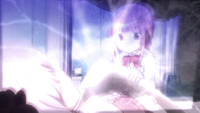
|
Iroha is shown to be with Ui in a hospital, possibly reflecting Giovanni's ill mother in the story. |
| |

|
The railroads Iroha uses daily is a single-track railway, which is very uncommon in developed, transit-dependent areas. This could be a reference to the single-trip Galactic Railroad bound for heaven as well as a metaphor for magical girls' destinies with no recovery. |
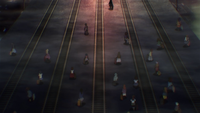
|
In the earlier edition of the novel, among the three people who have appeared after the Birdcatcher disappeared, a girl is wearing a "thin silver ring". In the Puella Magi series, the silver ring is a symbolic item for magical girls. |
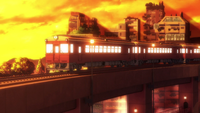
|
The train Iroha rides on presumably appears to be a diesel multiple unit, neither a steam locomotive nor an electric train, as there's no smoke and no overhead wires. It can be a reference to the novel, because it explains that the galactic train is not powered by steam or electricity in the earlier edition of the novel.
|
Episode 2
| Image | Notes |
|---|---|

|
The license plate number of the bus supposed to be bound for Satomi Medical Center but deviated by the witch is NGC-7000. It is the designation of North America Nebula near the Northern Cross, where Campanella makes up his mind to go to "the end of earth" to make his mother happy, a wish later fulfilled at the "true heaven" past the Southern Cross. |
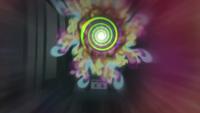
|
Caldwell 99 is the designation given to the Coalsack Nebula located between the Southern Cross and Scorpion constellations. In the story, Campanella ends his journey past the Coalsack. |
| |
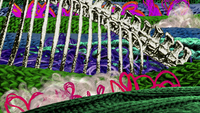
|
There is the huge ribbed skeleton of an animal in the barrier. In the novel, Giovanni and Campanella see the massive bones of an ancient animal on the "Pliocene Coast". See also Episode 16 section. |
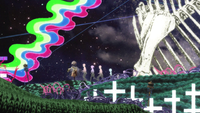
|
There are many things like crosses in the barrier. They probably are broken or imperfect fences. But, they can be an implication to the Northern Cross, which is the island where the white shining cross stands, or the Southern Cross, where the shining crosses of various colors stand like trees from the Milky Way, described in the novel.
|
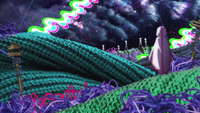
|
The sky of the barrier is a starry sky. There seems to be a depiction of the Southern Cross, which is called "Heaven" in the novel. |
Episode 3
| Image | Notes |
|---|---|
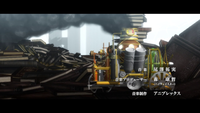
|
In third chapter of the novel, Giovanni fondly remembers a time before his father went missing. At the time, he played with Campanella's toy locomotive that ran on an alcohol lamp at his house. Episode 3 begin with a scene in which Touka makes her miniature locomotive run. This may be a reference to this chapter of the novel. |
Episode 8
| Image | Notes |
|---|---|
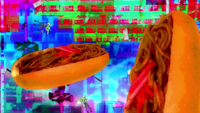
|
In the eighth chapter of the novel, Giovanni and Campanella see a man with a large key strapped to his waist, the reason being he is a lighthouse keeper which is explained in later chapters. In Episode 8, The rooftop Witch's familiars with bunches of keys, may be a reference to this chapter of the novel. |
Episode 12
| Image | Notes |
|---|---|
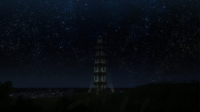
|
The observation tower where Mifuyu first deployed her Doppel is probably a reference to The Tower, Major Arcana card in Tarot. Although, it can also be a reference to the "Pillar of the Weather Wheel," a mysterious architectural structure that appears in the novel.
|
Episode 13
- At the end of the episode, Iroha is captured by Holy Mami and taken from Yachiyo, after having promised that they would stay together. This parallels Giovanni and Campanella, who promised each other that they would travel to the end of the universe together, until Campanella eventually gets off the train early because of his death. In the movie, Campanella (who mirrors Iroha in this instance) is pink, while Giovanni (Yachiyo) is blue.
Episode 16
| Image | Notes |
|---|---|
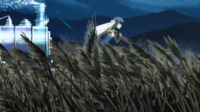
|
In the novel, the area around Swan Station is covered with silver grass meadows. |
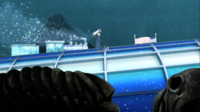
|
On the "Pliocene Coast", a researcher and his assistants are excavating a huge skeleton and fossil tracks. He explains to Giovanni and Campanella about the skeleton: the bones of the "Bos," the ancient ancestor of the cattle.
|
Episode 17
| Image | Notes |
|---|---|
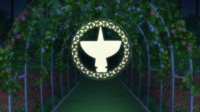
|
Kuroe points to the garden arches and says that the entrance to Fent Hope is "around Karasu-uri". Karasu-uri literally means "crow gourd", but its English name is "snake groud". In the novel, the attendees of the Galactic festival float lanterns made of the grouds down the river. |
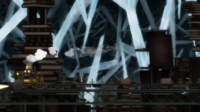
|
The toy locomotive which appeared in #Episode 3 reappears in a larger version. Also, the novel depicts landscapes such as trees like crystal work and a crystal palace. |
Episode 19
| Image | Notes |
|---|---|
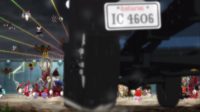
|
The license plate of Yachiyo's car reads "Antares IC 4606". Antares is the brightest star in the constellation of Scorpius and is described in the novels as "the scorpion's fire". IC 4606 is one of the nebulae associated with Scorpius, and surrounds Antares. |
Other works by Kenji
In-Game
- The description of Kanagi Izumi's doppel is a reference to The Cat Office[2].
- The story is about a cat who works at an office with other cats (as if they were humans). Since the cat gets cold easily he sleeps in the fireplace. This causes him to be covered in soot, and so he is known in the story as the "soot cat". His co-worker cats look down on him for this, and ultimately bully the soot cat in the workplace. In the end of the story a lion, implied to be the boss of the cats, secretly observes the workers and reveals himself. He then declares that the office is shut down. The last line of the story is the narrator saying "I half-agree with the lion." (ぼくは半分獅子に同感です.)
- Kuro's Witch form, Matasaburo, is a reference to Kazeno Matasaburō[3] and Kaze no Matasaburō[4] about a mysterious child who disappears after about ten days they came a rural elementary school.
- The former novel is a predecessor work of latter one and they are different in content. In the event story in which she appears, It is quoted poems from both of them. In the poem in former one, ざくろ (pomegranates, zakuro) appear, but it is replaced by other fruits, walnuts and Chinese quinces in the poem in latter one. Therefore, Zakuro, the familiars of the Witch, may be named after the poem in former novel.
- Nemu Hiiragi and Touka Satomi's Doppel are references to two draft-like predecessor works about The Life of Budori Gusuko[5]. Also, this novel itself can refer to Magia Record.
- Nemu's Doppel name, Pennen Nenemu is a reference to The Life of Pennen Nenemu[6].
- The titular character, Nenem is a ghost who lives in the ghost's world. The world is a different dimension from the world where humans live, and although ghosts can "appear" in the human world, it is a crime to appear without permission. Nenem loses his parents by a famine and his sister by an kidnapper, and is employed as a proletarian. He quits his job after working for ten years and then rises to the position of "the Chief Justice of the world". He does a fine job that all citizens praise, and in the process reunites with his sister, but he later becomes bloated with authority, slips and appears into the human's world, from his conceit. He laments his failure and declares his resignation. This story is a predecessor to The Life of Budori Gusuko, but it can be regarded as almost the opposite in content.
- Touka's doppel name is also a reference to Pennen Nolde is out for now[7].
- It is difficult to grasp the synopsis of this very short text, but it can be interpreted as the story of Norde trying to cope with the agricultural damage caused by a disorder about the solar activity.
- The Life of Budori Gusuko focuses on the titular character, Budori whose family is struck by a famine caused by cold-weather damage that inevitably takes his family. Eventually, when he is left with only his sister, she too is kidnapped by an abductor. He then meets various people, decides to contribute to society with his studies, and reunite with his sister along the way. This can be seen as both a reference to Iroha and her sister Ui, and later to Iroha's capture in Episode 13.
- Like Night on the Galactic Railroad, the novel was given a film adaptation where the characters were depicted as anthropomorphic cats. In this adaptation, Budori is blue cat, his sister is magenta cat and a mysterious kidnapper cat is given the name, "Kotori". This adaptation is also refer to The Life of Pennen Nenemuand Night on the Galactic Railroad.
- The character Budri encounters after his sister was kidnapped, is a man who runs the "Tegusu factory," a complex production facility of a silkworm farm and a silk mill. The worms raised in that factory is the Tussar silkworm, which is not exactly the same as the genus Bombyx, the true silkworm, but Shitori Egumo which is taken the form of a silkworm moth can be a reference to this.
- The design on the hood of the Wings of Magius is based on the antennae and eyes of a moth. It may be a reference to the silk worm moths that were farmed in the Tegusu factory. (At the same time, It could also be the comparison of the magical girls' desire for hope to phototaxis of moths.)
- Nemu's Doppel name, Pennen Nenemu is a reference to The Life of Pennen Nenemu[6].
- Ui Tamaki's Doppel name, Shitori Egumo, which means "I'm going alone," is taken from a poem titled 永訣の朝(The Morning of Last Farewell)[8]. This poem was written as he mourned and lamented passing away of his sister with illness.
- The oldest surviving text written by Kenji is a short composition titled "Yōsan" written by him about the sericulture industry when he was in the elementary school. Also, from the Meiji era to the early Showa era, sericulture prospered as one of Japan's most important industries, and close to Kenji's life. It is said that he met his end in the room where he had kept the silkworms. The design of Ui's Doppel can be a reference to these, as it is based on the silkworm moth.
- A phrase, "water-attribute Clammbon" appear in Episode 15 of the event story, KamiFest: Kamihama Idol Festival 2020. Clammbon is an unidentifiable word that appears in Yamanashi[9].
- Kuroe was initially an anime-only character, but later appeared in the game. Kuroe's Doppel name "Ichizo" was first revealed in the game. This name comes from the novel The Nighthawk Star[10]. See also below section.
- The novel tells the story of a nighthawk (also called "Nightjar" in English) who is despised by other birds as a very ugly bird. He decides to go somewhere far away by himself, flies to a much higher place in the sky, and finally becomes a star with a blue fiery light. In the first half of the story, the true hawk threatens to kill him if he doesn't change his name from "Nighthawk" to "Ichizo. The hawk, mighty and feared by the little birds, hates very much to share his name with the wretched him.
Anime
Episode 1
| Image | Notes |
|---|---|
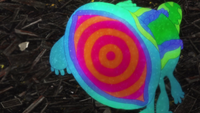
|
The multi-irised eye-like design of Box Wood can be a reference to a drawing for a flower bed entitled "Tearful Eye" from "MEMO FLORA", Kenji Miyazawa's gardening notebook. |
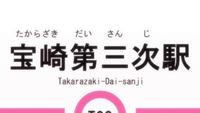
|
In Haru to Shura[8], an expression "第四次延長 (Stretching to the Fourth Dimension?)" can be found. This expression has been pointed out that it is related to The Night of the Galactic Railroad and Kenji Miyazawa's worldview. The name of Takarazaki-Dai-sanji station may also refer to this poem. |

|
When Iroha is waiting for the train at the station, the birds that take off from the perches are probably nighthawks. Kenji Miyazawa wrote The Nighthawk Star[10]. |
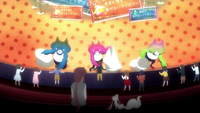
|
The fantastical scene in which Iroha and Kyubey converse in a circus tent can be a reference to "the Great Playing Company of the ghost illusionists" appeared in The Life of Pennen Nenemu[6].
|
Episode 2
| Image | Notes |
|---|---|
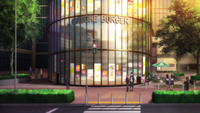
|
Gauche Burger may be a reference to Gauche the Cellist[11]. |
Episode 4
| Image | Notes |
|---|---|
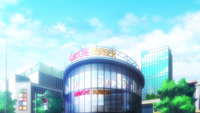
|
Gauche Burger appears again. |
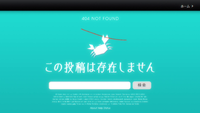
|
The crab used in the error screen of the SNS to represent Iroha's feelings may be a reference to Yamanashi[9] |
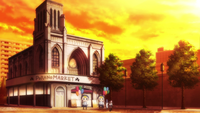
|
Porano Market may be a reference to The Polāno Plaza[12].
|
Episode 6
| Image | Notes |
|---|---|
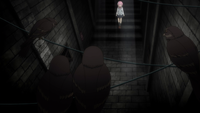
|
The birds, probably nighthawks that appeared in episode 1, reappear. |
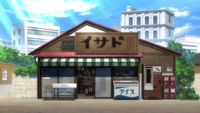
|
The penny candy store Isado is probably a quote from Yamanashi[9]. |
Episode 11
| Image | Notes |
|---|---|
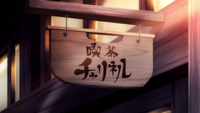
|
The name of the cafe that Iroha and Tsukuyo Amane visit, "Chalinell", is an musical instrument that appears in The Life of Pennen Nenemu[6]. |
Episode 12
- The observation tower appeared in Episode 12 can also be a reference to the Ryōunkaku. This Japanese early skyscraper does not appears in Kenji's novel but the film adaptation in 2012.
Episode 13
- Iroha's capture by Holy Mami may, in addition to being a parallel to Night on the Galactic Railroad, also be a reference to The Life of Budori Gusuko[5] and its own animated adaptation, where Budori (a blue cat) sets off to rescue his younger sister (a magenta cat) who had been kidnapped, and who meets various helpful characters on his journey while also figuring out a way to combat a widespread weather disaster to save many people from it.
Episode 15
| Image | Notes |
|---|---|
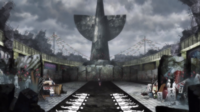
|
There are player flags behind a huge structure symbolising the Magius. See below section for details. |
Episode 18
| Image | Notes |
|---|---|
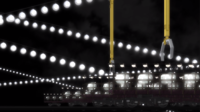
|
The "Witch plants" transported by rails could be a reference to the "Tegusu factory" in The Life of Budori Gusuko[5]. Its internal view appears to be somewhat similar to a real silk mill. Also, in the period when the sericultural industry was growing, railways were sometimes built in order to transport raw silk and silkworm cocoons. See also the above section. |

|
Kuroe's Doppel is shaped like a black bird. |
In Madoka Magica
- In the Episode 12 of Madoka Magica, Madoka rescue a magical girl, probably Himalayan people. There are prayer flags behind her. In The Life of Pennen Nenemu[6] , Nenemu slips and appears into the Tibetan mountain where the prayer flags fluttering.
- Witch of Train, the draft design appeared only in the Production Note (left side of p.121), may be a self-parody to Episode 8#C of Zan: Sayonara, Zetsubou-Sensei. Although, it can be also regarded a reference to Night on the Galactic Railroad[1].
- It is possible that the large hat of the Witch is repurposed for the design of Campanella, Yachiyo's Doppel.
Other Speculation about Reception and Influence of Kenji
- Chūya Nakahara is a poet and a contemporary of Kenji Miyazawa. Kenji was almost unknown during his lifetime, but Chūya promptly payed attention and was influenced by him.
- He wrote a poem titled Circus. This poem can have influenced the design of Walpurgisnacht's familiars and the fantastic circus scene in the Episode 1 of the anime.
- As a young man, Miyazawa began a small magazine with several friends named Azalea.
- Konoha Shizumi, Hazuki Yusa, and Ayame Mikuri were three orphans who lived in and made wishes for their orphanage, "Tsuzuji's House" (translated as Azalea's House or the Azalea House).
References
The works by Kenji Miyazawa referenced on this page are listed here. The links lead to the Aozora Bunko, Japanese digital library of out-of-copyright books. Also, his works with articles on Wikipedia are linked.
- ↑ 1.0 1.1 1.2
銀河鉄道の夜 (Night on the Galactic Railroad, Ginga Tetsudō no Yoru)
- There are several different editions of this novel. The final edition differs distinctly from the earlier editions, with the final edition removing the description of Professor Bulcaniro that caused Giovanni to ride the galactic train. There are four editions in Aozora Bunko, including the final edition, but here are two editions written in the modern kana usage.
- Earlier Edition, Final Edition
- Wikipedia JP, Wikipedia EN
- Jon Holt, Associate Professor of Japanese Literature in Portland State University presented about this novel and Kenji for study. If you want to know more details, please refer to this. (Be careful if you want to quote.)
- Holt, Jon P., "Ticket to Salvation: Nichiren Buddhism in Miyazawa Kenji’s 'Night on the Galactic Railroad' (Ginga tetsudō no yoru)" (2013). World Languages and Literatures Faculty Publications and Presentations. 45.
- http://archives.pdx.edu/ds/psu/12873
- ↑ 猫の事務所 (The Cat Office, Neko no Jimusho)
- ↑ 風野又三郎 (Matasaburō Kazeno, Kazeno Matasaburō)
- ↑ 風の又三郎 (Matasaburō the Wind, Kaze no Matasaburō)
- ↑ 5.0 5.1 5.2 グスコーブドリの伝記 (The Life of Budori Gusukō, Gusukō Budori no Denki)
- ↑ 6.0 6.1 6.2 6.3 ペンネンネンネンネン・ネネムの伝記 (The Life of Nenemu Pennennennennen, Pennennennennen・Nenemu no Denki)
- ↑ ペンネンノルデはいまはいないよ 太陽にできた黒い棘をとりに行ったよ (Nolde Pennen is out for now. He has gone to remove the Black Thorns from the Sun., Pennen Norude wa Ima wa Inaiyo. Taiyo ni Dekita Kuroi Toge wo Tori ni Ittayo)
- ↑ 8.0 8.1 春と修羅 (Spring and Asura, Haru to Shura), 永訣の朝 (The Morning of Last Farewell, Eiketsu no Asa) is included in this poetry collection.
- ↑ 9.0 9.1 9.2 やまなし (Wild Pear, Yamanashi)
- ↑ 10.0 10.1 10.2 よだかの星 (The Nighthawk Star, Yodaka no Hoshi)
- ↑ セロ弾きのゴーシュ (Gauche the Cellist, Sero Hiki no Gōshu)
- ↑ ポラーノの広場 (The Polāno Plaza, Porāno no Hiroba)
